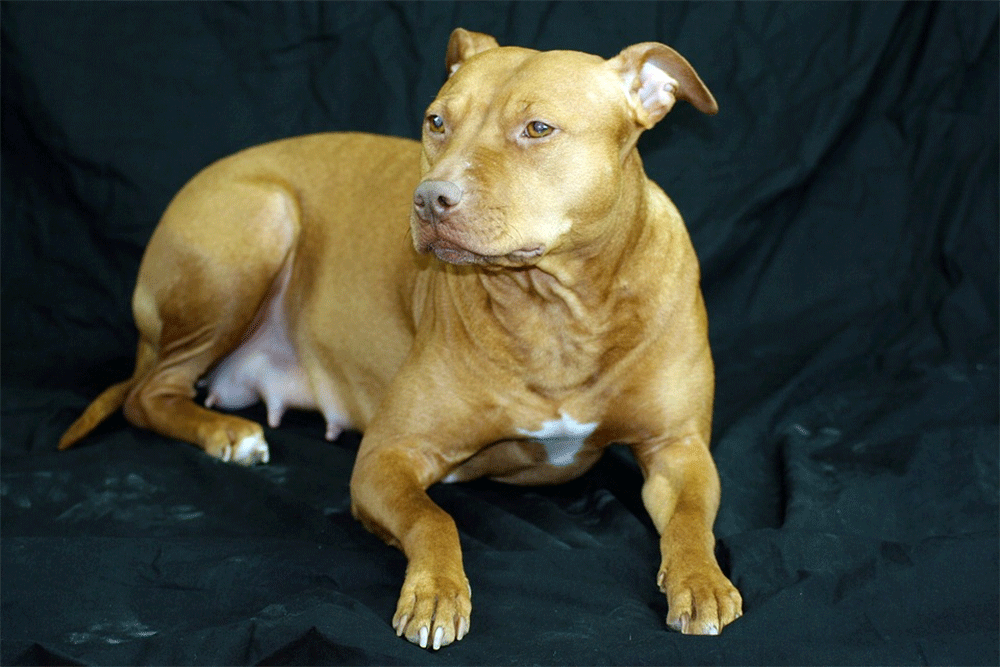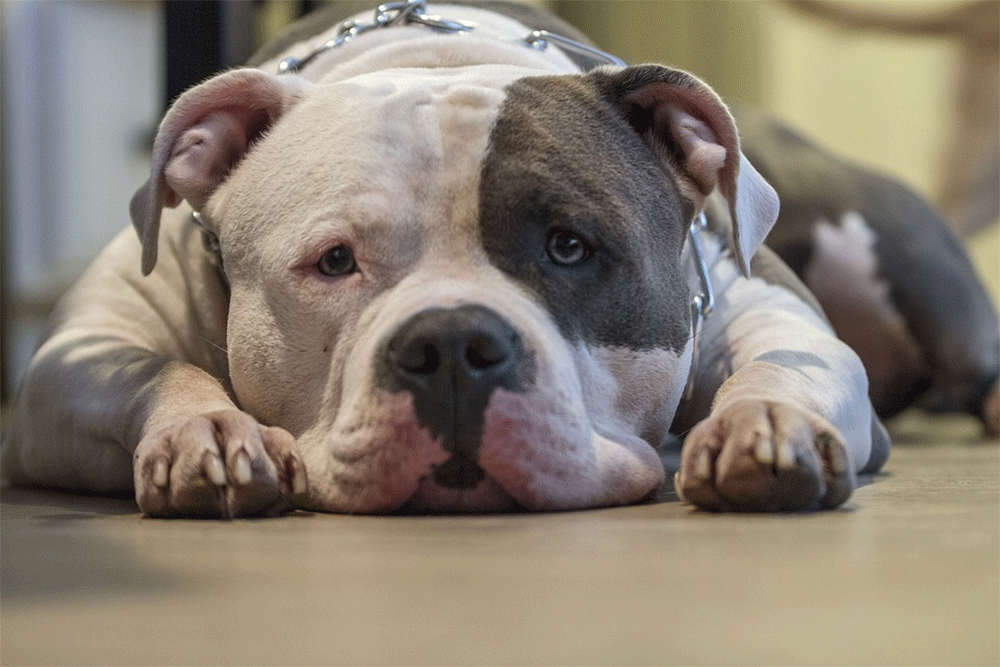Despite their questionable reputation in some countries in the world, pit bulls remain one of the most popular dog breeds in America. And it’s not hard to see why. You only need to look at a pitbull to see how cute and loveable they are. So it is understandable why there is such a huge demand for pit bull puppies here in the USA.
If you are new to breeding dogs, then your knowledge might be limited. Even if you have experience breeding other dogs, but are new to breeding pitbulls, then there are probably lots that you don’t know. Every breed behaves differently, and because of this the breeding process is slightly different.
One of the most common questions that people ask when it comes to breeding pitbulls, is ‘how long do their pregnancies last?’. That’s why we’ve put together this complete guide to pitbulls pregnancy with an additional pregnancy calendar to help you track your pitbull’s pregnancy from conception through to birth.

How long are Pitbulls Pregnant for?
Despite common misconceptions, all dog breeds are pregnant for the same amount of time. The length of pregnancy does not differ from breed to breed, so pitbulls are pregnant for a total of 9 weeks. However, there is usually a period of time in which you will not know that your dog is pregnant, which is why most dog pregnancies will range anywhere between 58 and 68 days in length.
So, pit bulls will usually be pregnant for roughly 9 weeks, give or take a couple of days. Compared to human pregnancies, this is a very short amount of time which is why puppies develop so much quicker. To help you track your dog’s pregnancy, we’ve put together a handy pregnancy calendar so that you can know what stage your dog is at as the weeks progress.
Pitbull Pregnancy Calendar
In Week 1 (day 1-7)
During the first week after conception, nothing will change in your dog. At least not visibly. Obviously, inside your dog’s womb the puppies are beginning to grow, but you will not be able to tell that any of this is happening.
So, during this week you should continue as normal. Feed your dog the same amount of food as you usually would, and walk her just as regularly as before. At this stage, you probably will not know that she is definitely pregnant, but little signs such as enlarged nipples, reduced energy and reduced appetite are signs that she might be expecting.
At this point, there is no need to change her routine, just carry on as normal until you can have her pregnancy confirmed in a couple of weeks.
In Week 2 (day 7-14)
In the second week of your dog’s pregnancy, you likely still will not notice much change in her behavior. So there is also no need to change her routine. But even though you will not be able to tell that anything has changed, there is a massive amount of development going on inside the womb.
At this stage of the pregnancy cells are developing insanely rapidly, and the puppy embryos will begin to transfer into your dog’s uterus ready to develop into puppies. This is when the pregnancy really begins, and yet your dog is likely to continue behaving exactly the same way as before.
So, keep on feeding her the same amounts, and keep on walking her regularly until the pregnancy progresses further.
In Week 3 (day 14-21)
It is during the third week of your dog’s pregnancy that the puppies are really beginning to become puppies. Before this they were simply embryos, but from this week onwards they will begin to look more and more like puppies.
But at this point, they are still incredibly small which is why you might still be unable to get your dog’s pregnancy confirmed. At week 3, the puppies will only measure approximately 1 cm in length, but they are growing fast and developing quickly as your dog comes to the end of her first trimester.
At this stage there is still no need to make alterations to your dog’s routine, just carry on walking her and feeding her the same as normal.
In Week 4 (day 21-28)
In terms of development, week 4 is a key stage. At this stage, your dog’s pregnancy will likely be confirmed by a vet as they will be able to feel the puppies with some gentle prodding. Your vet may also choose to do an ultrasound scan, which allows you to see the puppies as they grow.
At this point the puppies still only measure about 1.5 cm, but they are beginning to look like dogs. You will be able to see their facial areas, and also see the development of their spinal areas. But, while this is an exciting time in your dog’s pregnancy, it is also a risky time as this is when miscarriage is most likely. This is why it is time to start changing your dog’s routine.
So, going forward, you should limit the amount of exercise that your dog has so that she doesn’t become overly exerted. Your vet will likely recommend a change in diet so that she can get as many nutrients as possible to support the pregnancy.
In Week 5 (day 28-35)
At this stage major development is happening again with the puppies, as they develop claws, and paws, and whiskers, and begin to look even more like dogs. At this point, the genital areas have also developed so if you get lucky in the scan, a vet might be able to tell you what sexes the puppies are.
You will also begin to notice changes in your appearance. At this point, your dog will begin putting weight on rapidly, and you will find that her appetite is growing too. Due to this, you will also have to increase your dog’s food intake so that she has the strength to carry the puppies.
This is the point when you will also be able to find out how many puppies your dog is having which will help you prepare for her birth.
In Week 6 (day 35-42)
Before this week, your dog might have simply looked like she had gained a little weight. But from this point forward she will be visibly pregnant. In fact, you will probably notice a visible increase in the size of your dog’s waistline with every single day that passes.
As well as changes to her stomach, there will also be visible changes to your dog’s nipples as she prepares for nursing. As your dog’s nipples grow darker, the puppies in her belly will be developing their own unique markings as their fur changes color.
While your pitbull’s pregnancy continues to progress, you will notice that she is growing hungrier by the day. She may also begin looking for a warm and safe space to give birth. This is called nesting, and it is perfectly normal, so try your best to help her find her safe space.

In Week 7 (day 42-49)
This stage of the pregnancy is when some things that you might not have heard of before begin to happen. The main one being that your dog will begin to shed and lose fur. This is normal, and definitely not a cause for concern. It is simply your dog’s body clearing the hair around the stomach area, ready to feed the puppies.
Once again, you will need to increase the amount of food that you are giving your dog. At this stage, the puppies look just like pitbulls, and all they are going to do over the next weeks is continue to grow.
So, your dog is going to need all the strength she can get. At this stage, it is sometimes a good idea to increase the amount of calcium that your dog eats. This will filter through to the puppies and help them grow in strength ready for birth.
In Week 8 (day 49-57)
At this point in the pregnancy, you really need to be prepared for the puppies to arrive as it is fairly common for pitbulls to go into labor prematurely. So, you should continue living your life as normal, but also be cautious as you could soon be welcoming newborns into your home.
At this stage, your dog should not be completing any physical activity. In fact, you might find that she spends the majority of her time lying down and sleeping. But, some pitbulls are more energetic than others, so be mindful of this. If your dog is one that regularly does zoomies then she might trigger an early labor.
You will also be able to see the puppies moving beneath your dog’s skin at this stage as they will be very active. At this point, your dog will probably spend the majority of her time in her nesting area as she prepares to give birth.
In Week 9 (day 57-65)
The average length of a pitbulls pregnancy is 63 days. So, as you enter week 9 of your dog’s pregnancy, you should be aware of the fact that she could give birth at any minute. For this reason, it is important that you spend a lot of your time with your dog, just in case she should need aid, or something goes wrong.
If you have not experienced a dog giving birth before, you might be anxious for this moment. You might also be looking for signs that your dog is going into labor. As annoying as it might sound, you will simply be able to tell that things are moving along, and that your dog is ready to give birth. Additionally, other signs to watch out for are your dog losing her appetite, and also her slowing down and becoming quieter.
And then she will go into labor. It will likely be a stressful process, but there is nothing more beautiful than seeing new life be brought into the world. You will likely know how many puppies to expect from earlier scans, but if you are worried there may be a puppy left, you will be able to tell by gently prodding at her stomach. Then just like that, the 9 weeks have passed, and you have a whole litter of puppies to look after.
How many Puppies will my Dog have?
Unless you have an ultrasound scan completed to confirm how many puppies your dog is expecting, it can be difficult to identify how many puppies to expect. While there are averages for different breeds, some dogs have had litters much larger than expected, and others have had litters with just one puppy.
If you want to go off of averages, then most pitbulls will give birth to 5 puppies in a litter. These puppies will be quite small when firstborn, and will weigh just a few ounces. Five is a pretty big litter for a dog the size of a pitbull, which is why the puppies tend to be smaller as there is only so much room within their mother’s womb. So you should expect about 5 puppies in a litter.
Summary
In short, pitbulls are pregnant for approximately 9 weeks, with most dogs going into labor around day 63. The majority of the time, your pitbull will then go on to give birth to 5 adorable puppies, who weigh just a couple of ounces each.
